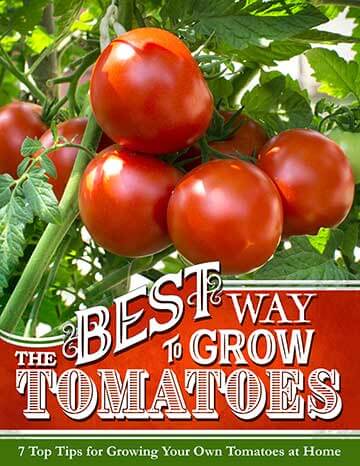
Two smiling retired pensioners are tending to the potted plants on a table, in the foreground and out of focus more ladies are helping
Gardening is supposed to be a joy, not an Olympic event in joint pain. If you live with arthritis, you’ve probably experienced the bittersweet moment of wanting to dig into your garden but knowing your wrists, knees or back will protest later. The good news? With a few changes to your techniques, tool choices and plant selection, you can keep gardening in a way that’s gentle on your body while producing baskets of fresh herbs, vegetables and fruit that are great for your health.
Discover 7 top tips for growing, harvesting, and enjoying tomatoes from your home garden—when you access the FREE guide The Best Way to Grow Tomatoes, right now!
Why Does Arthritis Affect Gardening Methods?
Arthritis changes how your joints move, bear weight and flex. When inflammation or stiffness sets in your thumbs, motions that used to feel automatic — twisting a trowel, kneeling to weed, pulling up stubborn roots — can suddenly feel like heavy labor. Your grip might weaken, your range of motion may shrink and swelling can make it hard to hold small tools for long.
It’s not just about joint pain, either. Studies have linked vein health and arthritis and potential implications for cardiovascular risk, which doctors track by measuring vein inflammation. Rheumatoid arthritis (RA) can inflame blood vessels, causing complications like rheumatoid vasculitis, which can trigger skin sores and tissue damage in 1 in 100 people with RA. Chronic venous disease can cause varicose veins that affect blood circulation and your leg health.
With so many people affected by varicose veins — 1 in 5 adults develop them — doctors recommend treatment with healthy habits like time in nature to increase movement and circulation. Gardening increases circulation to treat arthritis and weak veins, but how do you enjoy this hobby while protecting your joints?
Changing Up Techniques
You might have been able to spend all afternoon bent over garden beds in your 20s, gripping tools like you were trying to win a tug-of-war. Now? That same approach can aggravate arthritis and set you back days in recovery.
Switching up your techniques can make the difference between a productive, satisfying session and one that ends with you nursing swollen hands. Use these approaches to regular gardening motions:
- Holding tools: Keep your wrists in a neutral position — not bent up, down or sideways — to reduce strain on small joints. Use your larger joints and arm muscles for leverage rather than your fingers alone. Regular hand tools may not allow this new positioning, so consider hand-fitting or ergonomic options to better support your new movement.
- Digging: Apply gentle pressure rather than forcing the tool through the soil. Rock the handle slightly instead of pushing hard in one motion.
- Cutting and pulling: Let the sharpness of your tool do the work. Squeeze with your whole hand rather than just your fingertips, and keep your elbows close to your body for better support.
Why Tool Choice Matters With Arthritis
The right tools aren’t a luxury — they’re joint-saving necessities. Traditional gardening gear often forces your hands, wrists and knees into awkward, strained positions. Adaptive tools designed for arthritis protection do the opposite — they support neutral joint positions, reduce the force you need to apply and limit inflammation-causing micro-injuries.
Invest in these essentials.
Kneeling Pads and Gardening Chairs
A thick, high-density foam kneeling pad cushions your knees, absorbs shock and reduces pressure when you’re close to the soil. Even better? A low gardening chair or stool lets you work at ground level without the repeated up-and-down motion that can inflame hips and knees. Look for lightweight folding models you can easily move along the bed.
Padded Gloves
Compression gloves with padding do more than protect from blisters — they support joints and improve proprioception or your awareness of hand position. Wearing these can reduce swelling while supporting your hands during repetitive motions. Breathable fabric is key, especially if you’re gardening in warmer weather.
Compression Cuffs
Compression cuffs for wrists, elbows or knees can reduce swelling and maintain joint warmth, improving mobility. Choose a set with adjustable straps so you can loosen or tighten them as needed.
Upright Hand Tools
The traditional trowel requires wrist pronation, knuckle squishing and intense grip strength from small hand muscles. An upright or vertical-handle trowel keeps your wrist neutral, allows your knuckles space and shifts the work to larger joints like your elbow and shoulder.
These tools are handy for planting seedlings, weeding and light digging — and they can extend your gardening time without increasing pain.
Electric Power Tools
Electric trimmers, cultivators, blowers, garden vacuums and lightweight electric mowers do the repetitive heavy work of cutting, loosening soil, clearing debris and trimming edges. They replace manual pruners, hand cultivators, rakes and push mowers, which demand constant force from your wrists and back.
When choosing an electric tool, use lightweight, battery-powered models with ergonomic handles. These reduce fatigue and give you more control, and you only need to hold them without relying on force from delicate wrists and finger joints that may be painful when you have arthritis.
Gardening for Arthritis Control: 5 Plants to Grow and Eat
Some plants don’t just thrive with minimal maintenance — they also deliver anti-inflammatory or circulation-boosting benefits when eaten regularly. Cultivating them brings joy and future treatment options. These five fit beautifully into an arthritis-friendly garden and are easy to grow.
- Kale: Packed with antioxidants and 68% of your daily vitamin K, kale supports joint health and reduces inflammation.
- Turmeric: The root contains an anti-inflammatory compound called curcumin, which can help reduce swelling and alleviate pain.
- Blueberries: Blueberries are high in anthocyanins, which may help reduce joint pain and stiffness by reducing arterial plaque buildup that may contribute to poor circulation.
- Rosemary: Its antioxidant compounds have anti-inflammatory properties that can alleviate inflammatory conditions, and you can use it fresh in cooking or infused in oils.
- Sweet potatoes: This tasty root vegetable is rich in beta-carotene, which your body turns into vitamin A. Sweet potatoes can boost your joint health and collagen production, and they’re an antioxidant powerhouse that reduces inflammation.
Bringing It All Together
Gardening when you have arthritis is about adaptation, not giving up. By adjusting how you hold tools, using supportive gear and choosing plants that aid your body’s needs, you can keep cultivating a thriving garden without worsening joint pain. Protect your joints, listen to your body and remember that a slower pace in the garden still produces beautiful results.
Discover 7 top tips for growing, harvesting, and enjoying tomatoes from your home garden—when you access the FREE guide The Best Way to Grow Tomatoes, right now!




